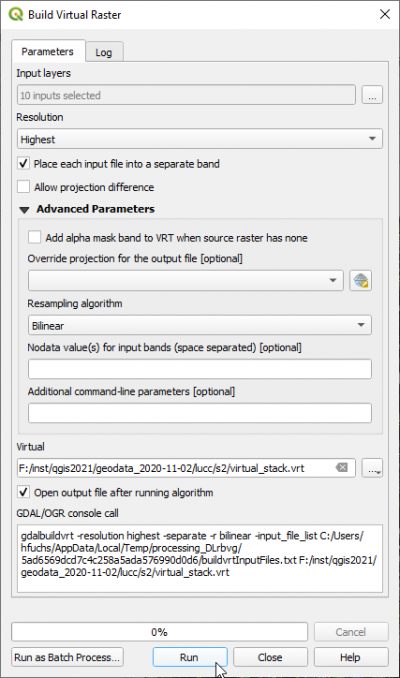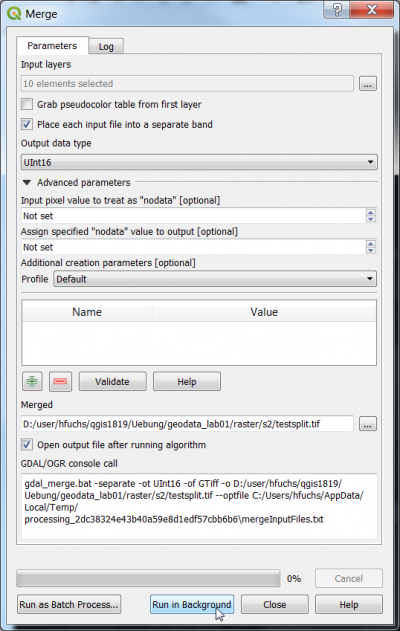Create stack
From AWF-Wiki
(Difference between revisions)
(→Create a new multiband raster file (single bands to multiband)) |
|||
| Line 4: | Line 4: | ||
* Input files: Click {{button|text=Select}} and click the checkbox of several single raster band files in the Multiple Selection window. Take care on the order of the files selection (here: B2,B3,B4,B5,B6,B7,B8,B8A,B11,B12) determines the rank of bands in the resulting multiband file. The rank of files can be changed by drag and drop in the Multiple Selection window. | * Input files: Click {{button|text=Select}} and click the checkbox of several single raster band files in the Multiple Selection window. Take care on the order of the files selection (here: B2,B3,B4,B5,B6,B7,B8,B8A,B11,B12) determines the rank of bands in the resulting multiband file. The rank of files can be changed by drag and drop in the Multiple Selection window. | ||
* Output ''Converted'' file: Click {{button|text=...}} {{button|text=Save to file ..-}}and choose a new file name. | * Output ''Converted'' file: Click {{button|text=...}} {{button|text=Save to file ..-}}and choose a new file name. | ||
| − | * Check the checkbox on '''Place each input file into a separate band''' (see screenshot below). | + | * !Check the checkbox on '''Place each input file into a separate band''' (see screenshot below). |
* Set output '''Resolution''' to {{typed|text=highest}}. | * Set output '''Resolution''' to {{typed|text=highest}}. | ||
* Set Resampling algorithm to {{typed|text=Bilinear}} | * Set Resampling algorithm to {{typed|text=Bilinear}} | ||
Latest revision as of 10:26, 27 October 2021
[edit] Build a virtual stack
A VRT (Virtual Dataset) is a list of links to input raster datasets. This has the advantage that no additional physical copy of the original files is necessary which saves storage capacity.
- Click Raster --> Miscellaneous --> Build Virtual Raster.
- Input files: Click Select and click the checkbox of several single raster band files in the Multiple Selection window. Take care on the order of the files selection (here: B2,B3,B4,B5,B6,B7,B8,B8A,B11,B12) determines the rank of bands in the resulting multiband file. The rank of files can be changed by drag and drop in the Multiple Selection window.
- Output Converted file: Click ... Save to file ..-and choose a new file name.
- !Check the checkbox on Place each input file into a separate band (see screenshot below).
- Set output Resolution to highest.
- Set Resampling algorithm to Bilinear
- Click Run
[edit] Create a new multiband raster file (single bands to multiband)
A multiband file stores several single raster layers in one file.
- Click Raster --> Miscellaneous --> Merge.
- Input files: Click Select and click the checkbox of several single raster band files in the Multiple Selection window. Take care on the order of the files selection: it determines the rank of bands in the resulting multiband file. The rank of files can be changed by drag and drop in the Multiple Selection window.
- Output data type Uint16
- Output Converted file: Click ... Save to file ..-and choose a new file name with extension *.tif
- Check the checkbox on Place each input file into a separate band (see screenshot below).
- Click Run in background

